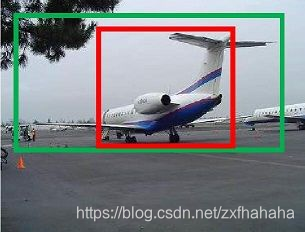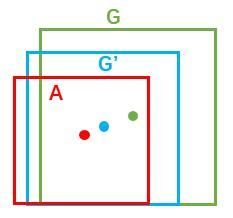faster rcnn细节
参考:https://zhuanlan.zhihu.com/p/31426458
https://www.cnblogs.com/dudumiaomiao/p/6560841.html
bounding box regression原理
如图所示绿色框为飞机的Ground Truth(GT),红色为提取的positive anchors,即便红色的框被分类器识别为飞机,但是由于红色的框定位不准,这张图相当于没有正确的检测出飞机。所以我们希望采用一种方法对红色的框进行微调,使得positive anchors和GT更加接近。
理论
对于窗口一般使用四维向量表示,分别表示窗口的中心点坐标和宽高。
对下图,红色的框A代表原始的positive Anchors,绿色的框G代表目标的GT,我们的目标是寻找一种关系,使得输入原始的anchor A经过映射得到一个跟真实窗口G更接近的回归窗口G’,即:
- 给定anchor 和GT
- 寻找一种变换F,使得,其中

那么这个变换F应该怎么寻找呢,比较简单的思路就是先做平移再做缩放 - 先做平移


- 再做缩放


观察上面4个公式发现,需要学习的是 这四个变换。当输入的anchor A与GT相差较小时,可以认为这种变换是一种线性变换, 那么就可以用线性回归来建模对窗口进行微调(注意,只有当anchors A和GT比较接近时,才能使用线性回归模型,否则就是复杂的非线性问题了。
接下来的问题就是如何通过线性回归获得。
线性回归就是给定输入的特征向量X, 学习一组参数W, 使得经过线性回归后的值跟真实值Y非常接近,即。
对于该问题,输入X是cnn feature map,定义为Φ;同时还有训练传入A与GT之间的变换量,即。输出是四个变换。那么目标函数可以表示为:
其中 Φ(A)是对应anchor的feature map组成的特征向量, 是需要学习的参数, 是得到的预测值(*表示 x,y,w,h,也就是每一个变换对应一个上述目标函数)。
为了让预测值与真实值 差距最小,设计L1损失函数:
函数优化目标为
为了方便描述,这里以L1损失为例介绍,而真实情况中一般使用soomth-L1损失。
需要说明,只有在GT与需要回归框位置比较接近时,才可近似认为上述线性变换成立。
faster rcnn
说完原理,对应于Faster RCNN原文,positive anchor与ground truth之间的平移量 与尺度因子如下:

对于训练bouding box regression网络回归分支,输入是cnn feature Φ,监督信号是Anchor与GT的差距 ,即训练目标是:输入 Φ的情况下使网络输出与监督信号尽可能接近。那么当bouding box regression工作时,再输入Φ时,回归网络分支的输出就是每个Anchor的平移量和变换尺度 ,显然即可用来修正Anchor位置了。
代码
box_coder.py
/home/flora/maskrcnn-benchmark/maskrcnn_benchmark/modeling/box_coder.py
box_coder.py的decode过程中,我们可以看到通过对anchor A进行平移和缩放得到修正后的预测框的过程
def decode(self, rel_codes, boxes):
"""
From a set of original boxes and encoded relative box offsets,
get the decoded boxes.
Arguments:
rel_codes (Tensor): encoded boxes
boxes (Tensor): reference boxes.
"""
#rel_codes.size()(box_regression) torch.Size([4000, 4])
#boxes.size()(concat_anchors) torch.Size([4000, 4])
boxes = boxes.to(rel_codes.dtype) #把anchors也转成浮点数torch.float32
#anchors的宽高和中心点
TO_REMOVE = 1 # TODO remove
widths = boxes[:, 2] - boxes[:, 0] + TO_REMOVE #x2-x1 torch.Size([4000])
heights = boxes[:, 3] - boxes[:, 1] + TO_REMOVE #y2-y1
ctr_x = boxes[:, 0] + 0.5 * widths
ctr_y = boxes[:, 1] + 0.5 * heights
wx, wy, ww, wh = self.weights ##(1.0, 1.0, 1.0, 1.0)
dx = rel_codes[:, 0::4] / wx #rel_codes的第0列
dy = rel_codes[:, 1::4] / wy #rel_codes的第1列
dw = rel_codes[:, 2::4] / ww #rel_codes的第2列
dh = rel_codes[:, 3::4] / wh #rel_codes的第3列
# Prevent sending too large values into torch.exp()
dw = torch.clamp(dw, max=self.bbox_xform_clip) ##self.bbox_xform_clip4.135166556742356
dh = torch.clamp(dh, max=self.bbox_xform_clip)
#对anchor进行微调,使positive anchors与GT更加接近
#先做平移
pred_ctr_x = dx * widths[:, None] + ctr_x[:, None]
pred_ctr_y = dy * heights[:, None] + ctr_y[:, None]
#再做缩放
pred_w = torch.exp(dw) * widths[:, None]
pred_h = torch.exp(dh) * heights[:, None]
#得到预测框的值(x1,y1,x2,y2)
pred_boxes = torch.zeros_like(rel_codes)
# x1
pred_boxes[:, 0::4] = pred_ctr_x - 0.5 * pred_w
# y1
pred_boxes[:, 1::4] = pred_ctr_y - 0.5 * pred_h
# x2 (note: "- 1" is correct; don't be fooled by the asymmetry)
pred_boxes[:, 2::4] = pred_ctr_x + 0.5 * pred_w - 1
# y2 (note: "- 1" is correct; don't be fooled by the asymmetry)
pred_boxes[:, 3::4] = pred_ctr_y + 0.5 * pred_h - 1
#torch.Size([4000, 4])
return pred_boxes
来源:CSDN
作者:zxfhahaha
链接:https://blog.csdn.net/zxfhahaha/article/details/103575661




